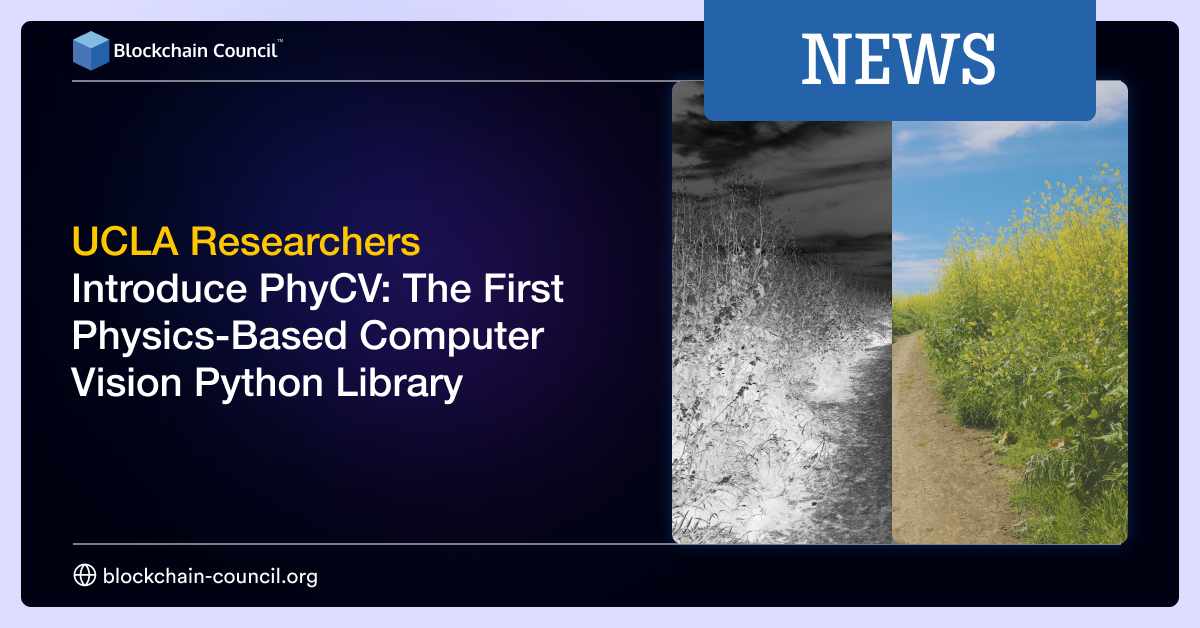
- Blockchain Council
- July 25, 2023
In the ever-evolving landscape of artificial intelligence, computer vision has emerged as a critical area of development. Among the forefront of these advancements is deep learning, a branch of AI where neural networks are trained on vast image datasets to recognize and classify objects, scenes, and events. The progress made in this domain has significantly improved image recognition and object detection, paving the way for transformative applications in various fields.
Breaking barriers and venturing into uncharted territory, the Jalali-Lab at UCLA has unveiled a groundbreaking Python library called PhyCV. A first-of-its-kind, PhyCV boasts the distinction of being the world’s premier physics-based computer vision library. It deploys sophisticated algorithms that draw inspiration from the laws and equations of physics to analyze visual data with unparalleled accuracy and efficiency. Unlike conventional approaches relying on hand-crafted rules, PhyCV’s algorithms are rooted in the elegance of mathematical equations, presenting a revolutionary paradigm in the realm of computer vision.
At the heart of PhyCV lie three cutting-edge algorithms, each with its distinct contributions to the field:
- Phase-Stretch Transform (PST) algorithm
The PST algorithm serves as a powerful tool for identifying edges and textures within images. Taking cues from the behavior of light passing through materials with unique diffractive properties, PST seamlessly detects the resultant image. This algorithm has demonstrated remarkable success in diverse applications, such as enhancing MRI scan resolutions and identifying intricate blood vessel patterns in retinal images. PST’s ability to unveil hidden details has proven invaluable in various domains, underlining its potential to enhance medical imaging and scientific research.
Also read: Apple is Testing Apple GPT to Enter the AI Race
- Phase-Stretch Adaptive Gradient-Field Extractor (PAGE) algorithm
Embracing the principles of physics, the PAGE algorithm excels in identifying edges and orientations within images. By simulating the path of light through a device featuring a diffractive structure, PAGE transforms the image into a complex function. In this transformation, valuable information about edges is retained in the real and imaginary components of the result. The versatility of the PAGE algorithm extends to various machine learning problems, where it can be harnessed as a potent preprocessing tool.
- Vision Enhancement via Virtual diffraction and coherent Detection (VEViD) algorithm
The VEViD algorithm stands as a beacon of innovation, empowering the enhancement of low-light and color images. By treating these images as spatially varying light fields and harnessing the principles of diffraction and coherent detection, VEViD catapults the accuracy of computer vision models in low-light scenarios to unprecedented heights. Moreover, VEViD-lite, an optimized version of the algorithm, emerges as a trailblazer in real-time 4K video enhancement, boasting an astonishing processing speed of up to 200 frames per second. The comparative study against popular neural network models demonstrates VEViD’s exceptional image quality while retaining its computational efficiency.
The availability of PhyCV on GitHub, along with its straightforward installation via pip, further solidifies its position as a transformative force in the realm of computer vision. Researchers and developers worldwide now have the opportunity to leverage these physics-inspired algorithms, spurring an era of accelerated innovation and novel applications.
Also read: Blockchain Development with AI
PhyCV’s applications extend beyond the realm of software, as its algorithms hold the potential for implementation in physical devices. This opens the door to a new realm of analog computing, where the fusion of physics and AI can revolutionize the landscape of edge computing applications. Real-time video processing on NVIDIA Jetson Nano serves as a testament to PhyCV’s ability to bridge the gap between theoretical brilliance and practical applications.
As AI continues to propel the boundaries of computer vision, PhyCV emerges as a pioneer, bridging the gap between the abstract world of physics and the tangible applications of AI. By delving into the fundamental laws of nature, PhyCV’s algorithms transcend the confines of traditional data-driven approaches, unlocking new possibilities and empowering developers to create a future where AI and physics work hand in hand.
The implications of PhyCV’s development resonate far beyond the research community, as its unique approach and unprecedented capabilities hold the potential to impact society at large. From revolutionizing medical imaging to optimizing surveillance systems, PhyCV’s contributions will undoubtedly touch the lives of millions, fostering advancements that were once considered the realm of science fiction.
UCLA researchers’ introduction of PhyCV marks a defining moment in the history of computer vision. With physics-inspired algorithms at its core, this groundbreaking Python library disrupts conventions, reshaping the landscape of AI and computer vision. PhyCV’s foray into the unexplored territory of physics-based methodologies embodies the spirit of innovation, and its potential to propel AI-powered technologies into uncharted territories is both awe-inspiring and humbling.
As we stand on the precipice of a new era, where the fusion of AI and physics unlocks new dimensions of possibilities, it is evident that PhyCV is not just an evolutionary step but a quantum leap towards a future where the boundaries of human achievement are defined by our imagination alone. UCLA’s PhyCV redefines the trajectory of computer vision, propelling us closer to the frontiers of human knowledge and ushering in a new era of technological marvels that will shape the course of humanity for generations to come.
Also read: Best 50 AI Tools PDF





































































 Guides
Guides News
News Blockchain
Blockchain Cryptocurrency
& Digital Assets
Cryptocurrency
& Digital Assets Web3
Web3 Metaverse & NFTs
Metaverse & NFTs
